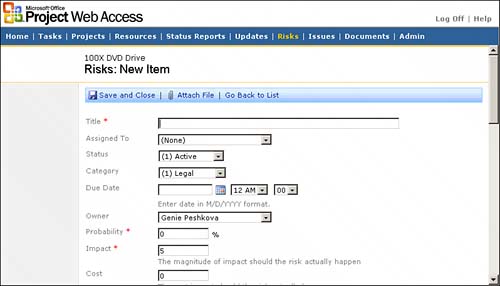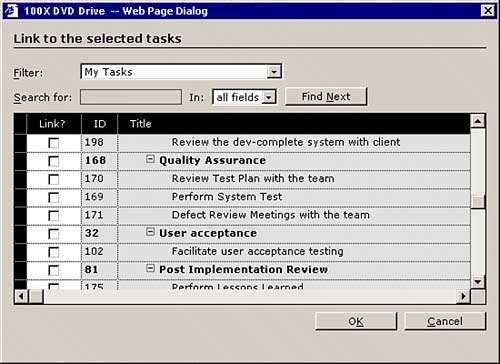Risks
| Risk management is a common process used by project teams to help analyze the probability and impact of challenges and opportunities to a project, which are called risks. After understanding the risks, the project team can then put in place plans to deal with the risks, if they should occur. PWA provides a tool for capturing and managing risks associated with projects. This tool includes the capability to describe the potential risk areas of the project, the probability that a risk will impact the project, any mitigation plan to minimize the potential risk, and the definition and triggering of the contingencies if the mitigation is not successful. This feature provides all the basic elements of a risk management repository including risk probability and impact, risk category, responsible team member, risk manager, critical dates, and descriptive elements. Selecting the Risks tab reveals a list of projects you have permissions to view as shown in Figure 18.10. Figure 18.10. View and submit risks in all projects. NOTE You must have Windows SharePoint Services to use the Risks feature in PWA.
Risk SummariesOn the initial projects Risks page, you may choose to select summaries of risk statistics for all projects you can view. This allows you to see the number of active, postponed, or closed risks for your projects. This grid can then be printed or exported to Excel using the links at the bottom of the grid. NOTE The Go to Selected Project Workspace selection, as shown in Figure 18.2, allows you to go to the workspace for the selected project if you want to view documents, risks, and issues related to a project you select. For details on the project workspace, see the "Collaboration Using Windows SharePoint Services" section earlier in this chapter. When you select a project name link, the risk list for that project is presented, and you can view, update, and report on risks for the project as shown in Figure 18.11. Features on this screen are described later in the chapter in "Creating Risks." Note that in Figure 18.11, the first risk listed is risk 6, which is the highest on the list. This is because, based on the probability and impact, it has the highest exposure. In other words, it has the highest risk factor of all risks rated. Notice how you can quickly view who is responsible for the risk, and when action on the risk is due. This screen allows you to quickly view all your risks based on the criteria you select (filtering and views are also described in the sections "Viewing and Reporting Risk Items" and "Filtering Risks" later in this chapter. Figure 18.11. Risk list for a project in PWA.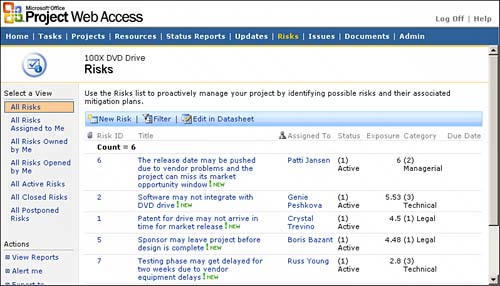 Creating RisksTo be able to add a risk to the project you must be a member of the Team Members site group, meaning that you have an assignment within the project schedule. The project manager of a project has full permissions to change the risks for the project. To add a risk, perform the following steps:
The fields that appear for a risk are as follows:
Linking List Items to TasksBased on what is happening on your project, you often need to show a dependency between a task in a project and a risk (or issue, or document), or perhaps to other risks, issues, or documents. PWA 2003 allows you to link individual risks or other list items in WSS to specific tasks within a project schedule. These links are visible as a document icon in the indicator column when you view the schedule details within the Project Center and on the Tasks page next to the task. When you create a new list item (risk, issue, or document), you have the option of clicking on the link that allows you to select a task the item is related to. Figure 18.13 shows you the fields where you can select the link. This is similar on all lists.
Figure 18.13. Selecting to link to tasks. The selected task names then appear in the edit form below the final field in the list form. NOTE When a risk is defined for a project, a graphical icon is displayed adjacent to the project within the Project Center Summary view. If a risk is attached to a specific working task, a graphical icon appears within the Project Center detail views. If you select a risk graphic icon, PWA opens the appropriate project risk group for review and updates. Editing, Deleting, and Alert Me Actions on RisksFrom the project's risk list, the Risk ID and Title are hyperlinks that take you to the detailed view of an existing risk. From this view, you can edit, delete, or create an alert for the risk so that you can be notified about changes to that risk. Select Edit Risk, Delete Risk, or Alert Me from the toolbar. You can also click to the right of the risk description and, in the drop-down list that displays, select Edit Risk, Delete Risk, or Alert Me as shown in Figure 18.15. Figure 18.15. Drop-down list to select action on risk.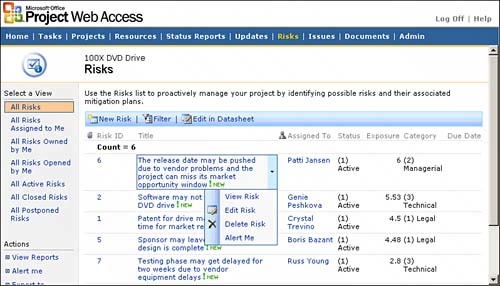 Viewing and Reporting Risk ItemsYou have several options for viewing and reporting on the risks for a project. These especially come in handy for sorting through long risk lists, or analyzing the risks that could affect your project. Filtering RisksTo view the risks on your project in different ways, you can select one of numerous filters under Select a View in the side pane as shown in Figure 18.15. You can also select Filter on the toolbar above the risk list and use the filters from the drop-down lists that appear above each field on the list. For example, you could view only those risks assigned to a particular team member on your project. After enabling the filtering function, the Filter button changes the Change Filter or Hide Filter choices to change or remove the filtering you have applied. View ReportsUnder Actions in the side pane, you can select View Reports. On the Report Types screen, select the type of report you want to view. You can analyze risks by category, owner, or dates. Figure 18.16 shows a category report. Figure 18.16. A category risk report. Alert MeYou can use the Alert Me option at the risk list level to receive an email to notify you of any changes for all risks in the project. You can choose to be notified when risks are added, changed, or deleted, or for all changes. You can also choose to be notified immediately or in a daily or weekly summary. Figure 18.17 shows the options for how you want the emails to be sent to you when the risks for this project are updated. Figure 18.17. Alert selections for a list item.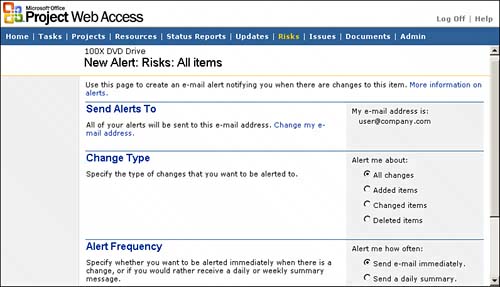 NOTE This is different from the Alert Me function described previously for individual risks. You can select to be emailed about individual risks and all risks on a project. Export to SpreadsheetYou can export the risks list to an Excel spreadsheet as shown in Figure 18.18. To do so, click on Export to Spreadsheet in the Actions side pane on the risk list for the project. This is especially handy for taking the list of risks to meetings to discuss and update them within the meeting itself, or for sharing the risk list with others who may not have access to Project Server. Then, after you have made changes in Excel, you can use the Synchronize with Project Server selection on the side pane to bring the changes you made in Excel back into Project Server. Figure 18.18. The risks list exported to an Excel spreadsheet. Edit in DatasheetThe risk list can also be mass edited by using the Edit in Datasheet option on the toolbar. This presents the data elements from the view in a datasheet form. You can edit the risks more easily and more quickly than in the Standard view. TIP In the Datasheet view, select the Task pane and explore the various Microsoft Office tools you can use to analyze and report on risks. For example, you can use Create an Excel PivotTable Report to chart your risk trends. Modify Settings and ColumnsThe Modify Settings and Columns feature allows you to make changes to the risk columns and values to customize the risks repository to match your risk management standards.
Synchronize with Project ServerUse this function to synchronize data you might have changed in Excel or Access, if you exported the risks to an Excel spreadsheet or an Access database. When you select this feature, it updates the data changed in those applications within Project Server. |
EAN: 2147483647
Pages: 227

